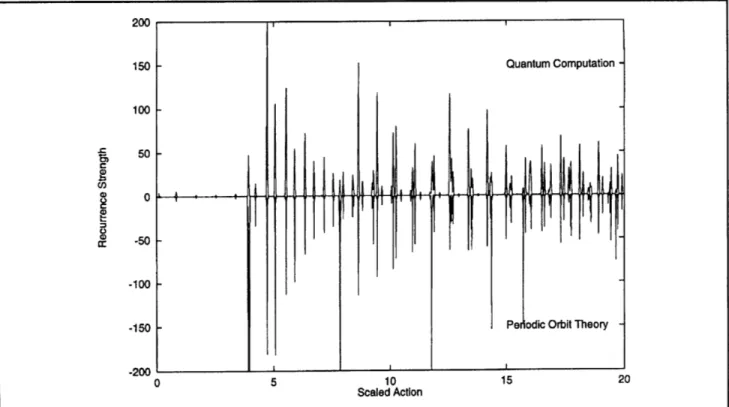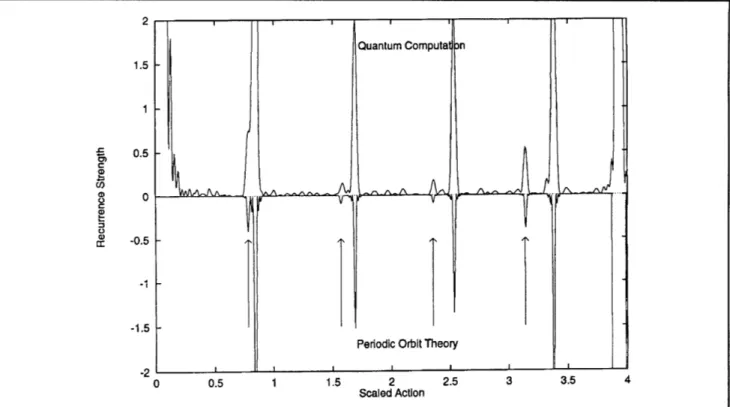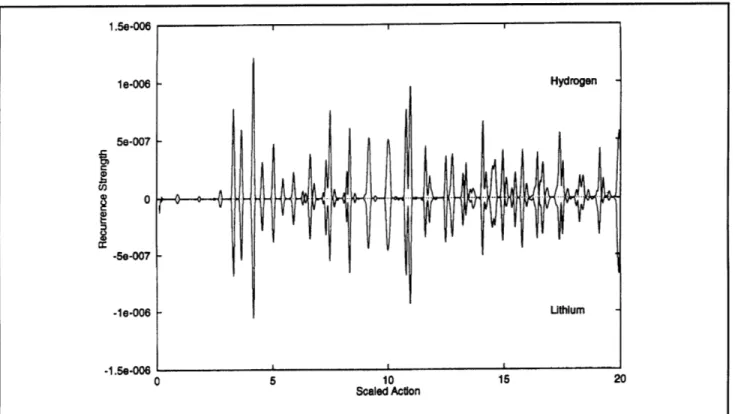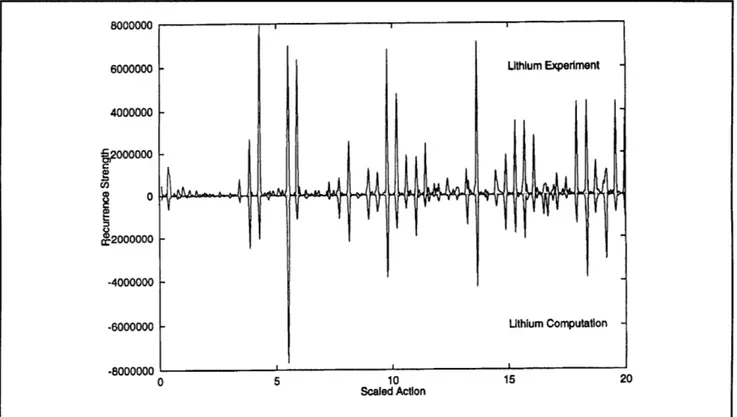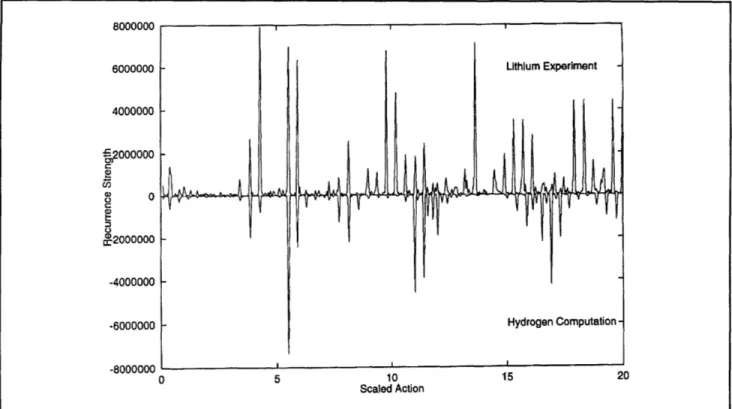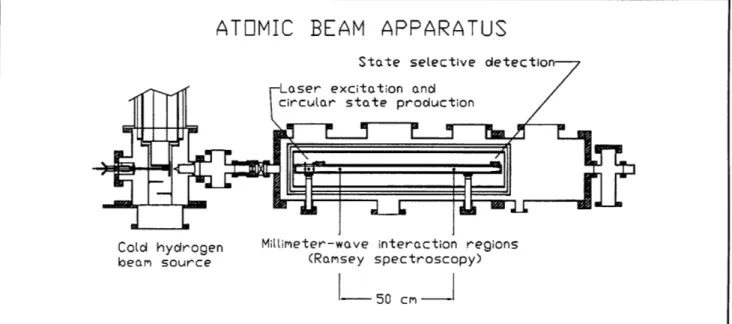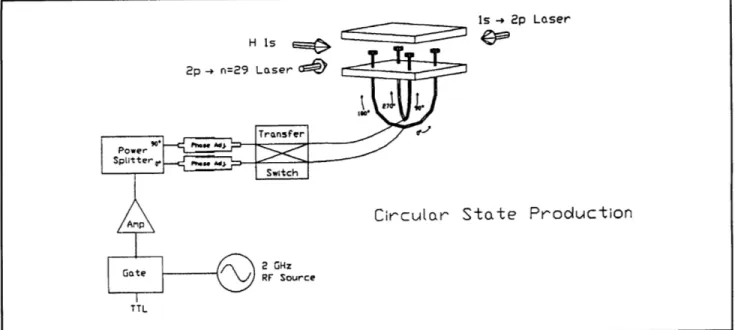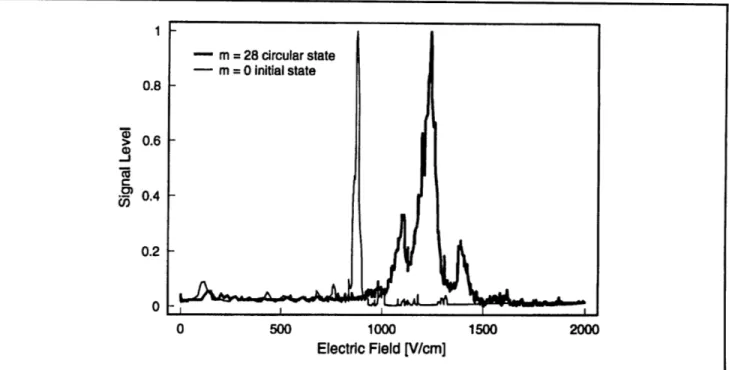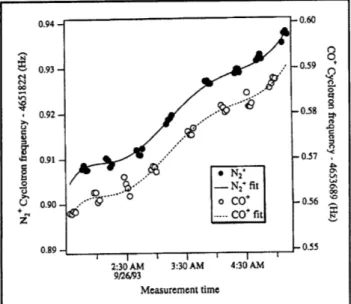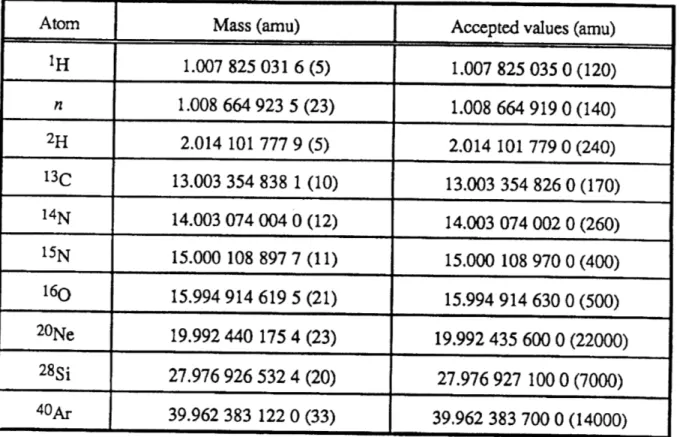Chapter 2. Basic Atomic Physics
Chapter 2. Basic Atomic Physics
Academic and Research StaffProfessor Daniel Kleppner, Professor David E. Pritchard, Professor Wolfgang Ketterle
Visiting Scientists and Research Affiliates
Dr. Theodore W. Ducas,1 Dr. Fred L. Palmer, Dr. H. Joerg Schmiedmayer, Stefan Wehinger
Graduate Students
Michael R. Andrews, Michael P. Bradley, Michael S. Chapman, Michael W. Courtney, Kendall B. Davis, Frank DiFilippo, Joel C. DeVries, Christopher R. Ekstrom, Troy D. Hammond, Jeffrey R. Holley, Hong Jiao, Michael A. Joffe, Robert I. Lutwak, Marc O. Mewes, Vasant Natarajan, Richard A. Rubenstein, Neal W. Spellmeyer
Undergraduate Students
Ilya Entin, Philip M. Hinz, Wan Morshidi, Amrit R. Pant, J. David Pelly, Abraham D. Stroock, Bridget E. Tannian, Stanley H. Thompson, John J. Wuu, Peter S. Yesley
Technical and Support Staff
Carol A. Costa
2.1 Testing Quantum Chaos with
Rydberg Atoms in Strong Fields
SponsorsNational Science Foundation Grant PHY 89-19381 Grant PHY 92-21489
U.S. Navy - Office of Naval Research
Grant N00014-90-J-1322
Project Staff
Michael W. Courtney, Hong Jiao, Spellmeyer, Professor Daniel Kleppner
Neal W.
Interest in the behavior of Rydberg atoms in strong fields has resulted in the generation of high resolu-tion experimental spectra and accurate calcularesolu-tions for atoms in electric and magnetic fields and also experimental data in the low field regime for electric and magnetic fields. The principal motivation for this work has been to understand atomic systems under external perturbations similar in magnitude to the unperturbed energy. Rydberg atoms are central to this research, because field strengths available in the laboratory are comparable with atomic fields of
highly-excited states. We have chosen to work with hydrogen because it is the simplest system to
study. Alkali metal atoms are also of interest, because they break the zero field degeneracy of hydrogen and are much more tractable exper-imentally.
The quantum mechanics of alkali Rydberg atoms in strong electric fields is now believed to be well understood. Much has been learned about diamag-netic hydrogen, but some important regimes remain to be explored, and our knowledge of hydrogen needs to be extended to other alkalis. For example, we know little about the alkali Rydberg atoms in parallel electric and magnetic fields and even less about them when the fields have arbitrary or perpendicular orientation.
With the exception of hydrogen in an electric field, the classical analogues of all these systems undergo a transition from order to chaos. In seeking to understand the connection between quantum mechanics and classical chaos, the problem of hydrogen in a magnetic field has been extensively studied. However, the more general problem of Rydberg atoms in strong fields provides a richer testing ground for theories describing "quantum chaos."
We have developed techniques for carrying out high resolution laser spectroscopy on the lithium
Chapter 2. Basic Atomic Physics
atom in strong static fields. In addition, we have developed techniques for computing the spectra of alkali atoms in both strong electric and magnetic fields. The differences between lithium and hydrogen are minor for many cases of interest. In other cases, the core potential itself is the cause of classical chaos and becomes essential to consider. In the experiment, a lithium atomic beam, excited by a laser, transfers atoms from the 2S state to the 3S state by a two-photon transition, and a second laser excites the atoms to Rydberg states.
The Rydberg atoms are detected by electric field ionization. Two methods for relating quantum spectra to the classical dynamics system are (1) periodic orbit theory and (2) use of statistical corre-lations. In the past year, we have made progress in testing both these methods which characterize quantum chaos.
Classically chaotic systems possess a proliferation of periodic orbits. Periodic orbit spectroscopy is a technique used to relate the quantum mechanical spectrum to the periodic orbits of the corresponding classical system.2
The hamiltonian of hydrogen in a magnetic field is given by
2
S 1 1 LB + 1 B2p2 (1)
2 r 2 8
This hamiltonian can be rescaled using the relations: r= B-213
r, p = B1/3p, and L=
B-1/3L. gives the scaled hamiltonian,
2
P 1 1 z + 1 2
2 2 8
This
where -= B-2/3H. As a result, the classical dynamics depends only on the parameter EB = B-2/3E and not on E and B separately.
The semi-classical Bohr-Sommerfeld quantization
condition for the two non-separable scaled
coordi-nates
p,
z is
S = (2r) 1 (ppdp + pzdz) = nB- 1/3,
where S is the scaled action of a closed classical orbit. As a result, S = n B-1/3 gives rise to equidistant lines on a scale B-1/3 in a spectrum
taken at constant scaled energy EB. In other words,
each peak in the Fourier transform of a constant scaled energy spectrum corresponds to the scaled action of a periodic orbit.
This has been shown experimentally.3 In addition, Delos and his colleagues have developed the tech-niques of periodic orbit theory which use classical dynamics to compute the actions of the periodic orbits and semi-classical techniques to compute the strength of the periodicities. The strength of the periodicities is called the recurrence strength, because an outgoing spherical wave will recur at times corresponding to the periods of the periodic orbits of the classical system. Figure 1 shows the Fourier transform of a computed constant scaled energy spectrum compared with the results of peri-odic orbit theory (courtesy of Dr. J.A. Shaw of the College of William and Mary). The recurrences from periodic orbit theory are in good agreement, except for peaks near scaled actions of 4, 8, 12, 16, and 20, which are systematically much stronger in the periodic orbit theory results. These peaks are due to the 5th, 10th, 15th, 20th, and 25th return of the orbit in the z=0 plane. These orbits have a bifurcation very close to the scaled energy shown here which makes their recurrence strength difficult to accurately compute.
We are planning periodic orbit spectroscopy both experimentally and computationally. Periodic orbit spectroscopy requires varying the energy and the magnetic field simultaneously so that scaled energy
Es remains constant. Since our computational tech-niques have been verified by our experiments, and since it is easier to accurately vary E and B while maintaining a constant EB numerically than exper-imentally, we have proceeded computationally in the regions where the computations have been veri-fied. In addition, our experiment is limited to exciting only odd-parity states of lithium. Computa-tionally, we have been able to explore both odd and even parity hydrogen and lithium. In this way, we
2 A. Holle, J. Main, G. Wiebusch, H. Rottke, and K.H. Welge, "Quasi-Landau Spectrum of the Chaotic Diamagnetic Hydrogen Atom,"
Phys. Rev. Lett. 61: 161 (1988); J.-M. Mao and J.B. Delos, "Hamiltonian Bifurcation Theory of Closed Orbits in the Diamagnetic
Kepler Problem," Phys. Rev. A 45: 1746 (1992).
3 A. Holle, J. Main, G. Wiebusch, H. Rottke, and K.H. Welge, "Quasi-Landau Spectrum of the Chaotic Diamagnetic Hydrogen Atom,"
Phys. Rev. Lett. 61: 161 (1988); T. van der Veldt, W. Vassen, and W. Hogervorst, "Quasi-Landau Structure of Diamagnetic Helium
Chapter 2. Basic Atomic Physics
Figure 1. Recurrence strength for EB = - 0.7, m = 0, odd parity. The results
to facilitate comparison. Each peak corresponds to a periodic orbit.
have made several discoveries with implications for However, liti
periodic orbit theory. at a much
lithium is coi It was previously believed that if an orbit lies on the which hydro node of the outgoing wavefunction, the recurrence sents a pare strength is zero.4 Since odd parity wavefunctions
is known th have a node in the z=0 plane, it was believed that lithium is ne the recurrence strength of the orbits in the z=0 also been si plane are zero. Our quantum computations show odd-parity lit that the recurrence strength is small but non-zero. system. TI J.A. Shaw and J.B. Delos have derived a new wavefunctior semiclassical formula for the recurrence strength of chaos-causil a periodic orbit at a node of the quantum
wavefunction. The results are compared with the In contrast, quantum computation in figure 2. do not have
spectra of e The classical dynamics of both lithium and level statist hydrogen in a magnetic field show a transition from spectra of e order to chaos as the scaled energy is raised. energy leve
of periodic orbit theory are multiplied by - 1
hium's core causes it to become chaotic lower EB than hydrogen. As a result, mpletely chaotic at EB = - 0.6, a value at igen is completely regular. This pre-dox for periodic orbit theory, because it at the spectra of odd-parity diamagnetic arly identical to that of hydrogen.6 It has hown7 that the energy level statistics for hium corresponds to a regular classical his is expected, since the odd parity is have a node in the region of the ng core.
the wavefunctions of even-parity lithium a node at the core. As a result, the ven-parity lithium have chaotic energy-ics and are very different from the ven-parity hydrogen, which has regular I statistics. We arrive at a paradox,
4 M.L. Du and J.B. Delos, "Effect of Closed Classical Orbits on
Phys. Rev. A 38: 1896-1912 (1988).
Quantum Spectra: Ionization of Atoms in a Magnetic Field: I and II,
5 Private communication from Dr. J.A. Shaw, College of William and Mary, Williamsburg, Virginia.
6 C. lu, G.R. Welch, M.M. Kash, D. Kleppner, D. Delande, and J.C. Gay, "Diamagnetic Rydberg Atom: Confrontation of Calculated and
Observed Spectra," Phys. Rev. Lett. 66: 145 (1991).
7 G.R. Welch, M.M. Kash, C. lu, L. Hsu, and D. Kleppner, "Experimental Study of Energy-Level Statistics in a Regime of Regular
Classical Matter," Phys. Rev. Lett. 62: 893 (1989); G.R. Welch, M.M. Kash, C.-H. lu, L. Hsu, and D. Kleppner, "Positive-Energy Structure of the Diamagnetic Rydberg Spectrum," Phys. Rev. Lett. 62: 1975 (1989).
200 150 Quantum Computation 100 0 50 0) I
a
-50 -100-150 Per odic Orbit Theory
-200
0 5 10 15 20
Chapter 2. Basic Atomic Physics
Figure 2. Recurrence strength for EB = - 0.7, m = 0, odd parity. The information in figure 1 is shown enlarged 100 times.
The arrows point to the orbits in the z = 0 plane.
because classical dynamics does not "know" about parity. As a result, periodic orbit spectroscopy should yield the same periodic orbits for both odd and even parity hydrogen. Similarly, periodic orbit spectroscopy in lithium should give the same peri-odic orbits, regardless of parity. In both hydrogen and lithium, the recurrence strengths may vary between the odd and even parity cases, because these are computed by including parity in the semi-classical methods. However, since odd parity hydrogen and lithium have nearly identical spectra, we expect the periodic orbits of lithium and hydrogen to be nearly identical. This seems to be the case from looking at the recurrences in figure 3. However, we do not expect a completely chaotic system to have the same periodic orbits as a regular system. In addition, from a quantum mechanical point of view, we have no reason to expect that the spectrum of even parity lithium will exhibit the same periodicities as even parity hydrogen. However, figure 4 shows that many of the recurrences are the same. This is a victory for periodic orbit theory. The case of even parity lithium also has many extra recurrences, indicating extra periodic orbits. This is a challenge to periodic orbit theory, because to resolve this paradox, peri-odic orbit theory must find these extra periperi-odic orbits and compute their recurrence strengths in even-parity lithium. Furthermore, it also needs to
be shown that all these extra periodic orbits have a very small recurrence strength in the odd parity case.
In the case of Rydberg atoms in a strong electric field, parity is not a good quantum number. Hydrogen in an electric field is regular and chaos is caused completely by the core. The hamiltonian of hydrogen in an electric field is given by
p2
j=
212 + Fz,
rand this hamiltonian can be rescaled by substituting r = F- 2r, p = F14p. As a result, the classical dynamics of hydrogen in an electric field depends only on the parameter EF = F-1/2E and not on E and F separately. In analogy with the magnetic field case, each peak in the Fourier transform of a spec-trum taken at constant EF corresponds to the scaled action of a periodic orbit. These classical scaling rules are exact for hydrogen and good approxi-mations for lithium.
In the case of lithium in an electric field, we have done experiments for both the cases m = 0 and m = 1. The m = 1 case is regular and nearly identical to hydrogen, because the angular momentum barrier causes the wavefunction to have a node at the core. 2 1.5 1 -0.5 0 -0.5 -1.5 -2 0 0.5 1 1.5 2 2.5 3 3.5 4 Scaled Action
Chapter 2. Basic Atomic Physics
The m=0 case is chaotic for all regions of interest. The experimental result for EF - 0.3 is compared with quantum computations for lithium and hydrogen in figures 5 and 6. Notice that lithium and hydrogen have many recurrences in common, but just as in the case of even-parity diamagnetic lithium, there are extra recurrences which need to be computed by periodic orbit theory. Several of these extra peaks occur near a scaled action of 14.
Figure 3. Recurrence strength for Es - 0.6, m - 0, odd parity. Notice hydrogen and lithium.
Spectral correlations have also been useful in char-acterizing spectra in regions of classical chaos. Computing the spectra in regions of total chaos has enabled the testing of a new class of universal cor-relations in spectra of chaotic systems as a param-eter is changed. Our computations enabled MIT Professor Boris Altshuler's group to verify their new class of universal correlations on a real physical system.8 This new class of correlations has been confirmed in the chaotic regions of both diamag-netic hydrogen and lithium.
that it shows the same periodic orbits for
8 B.D. Simons, A. Hashimoto, M. Courtney, D. Kleppner, and B.L. Altshuler, "New
Hydrogen in a Magnetic Field," Phys. Rev. Lett. 71: 2899 (1993).
Class of Universal Correlations in the Spectra of
1.5e-006 le-006 Hydrogen 5e-007 0 A -5-007 -le-006 Uthlum -1.5e-006 0 5 10 15 20 Scaled Action
Chapter 2. Basic Atomic Physics 2e-007 1.5e-007 le-007 Hydrogen -5e-008 -le-007 - Lithum -1.5e-007 I 0 5 10 15 20 Scaled Action
Figure 4. Recurrence strength for EB - - 0.6, m - 0, even parity. Notice that it shows that lithium has many periodic orbits in common with hydrogen, but that there are extra periodic orbits present in lithium.
6000000 Lithium Experiment 4000000
-o
C2000000 -4000000 -6000000 Lithium Computation -.8000000 , a 0 5 10 15 20 Scaled ActionFigure 5. Recurrence strength of lithium for EF =- 3.0, m = 0. The experiment is compared with quantum computations
Chapter 2. Basic Atomic Physics
Figure 6. Recurrence strength for EF = - 3.0, m = 0. The experiment for lithium is compared with quantum computations for hydrogen.
2.2 Millimeter-Wave Frequency
Measurement of the Rydberg Constant
Sponsors
Joint Services Electronics Program
Contract DAAL03-92-C-0001
National Science Foundation
Grant PHY 89-19381
Grant PHY 92-21489
Project Staff
Joel C. DeVries, Dr. Theodore W. Ducas, Jeffrey R.
Holley, Robert
I.
Lutwak, Professor Daniel Kleppner
The Rydberg constant R. relates the wavelengths
of the spectrum of atomic hydrogen to practical
lab-oratory units. It is a so-called fundamental
con-stant, for it relates numerous quantum properties to
laboratory units. Recent advances in optical
wave-length metrology have enabled experiments using
laser spectroscopy to measure R. with accuracy
approaching two parts in 1011.9
Although R,. is the most accurately measured fun-damental constant, forthcoming high-precision experiments which will depend on R,. as an auxil-iary constant, demand even more accurate meas-urement. Because the practical limit of measuring wavelengths, about 1 part in 1010, has been reached, progress in the measurement of R~. requires measuring the frequency of spectral lines. Because the speed of light is now defined, by measuring cR., the "Rydberg frequency," a new standard is created.
Our approach involves preparing highly excited "Rydberg" states of atomic hydrogen, n = 29, and measuring millimeter-wave transitions to nearby states. Because the millimeter wave signal is gen-erated coherently from a frequency standard based on an atomic clock, our measurement can make
use of the high precision of frequency metrology. The goals of our experiment are three-fold: First is the reevaluation of R. itself, providing an inde-pendent check, in a different regime, of other evalu-ations based on optical wavelength metrology. Second is the measurement of the ground state
9 T. Andreae et al., "Absolute Frequency Measurement of the Hydrogen 1S-2S Transition and a New Value of the Rydberg Constant,"
Phys. Rev. Lett. 69: 1923 (1992); F. Nez, et al., "Precise Frequency Measurement of the 2S-8S/8D Transitions in Atomic Hydrogen:
Chapter 2. Basic Atomic Physics
Lamb shift. Because our measurements involve high angular momentum states for which the Lamb shift is extremely small, our results may be com-pared with optical measurements of transitions between low-lying states to yield an improved measurement of the Lamb shift. Third is to provide a frequency calibration of the spectrum of hydrogen, enabling the creation of a comprehensive frequency standard extending from the radio-frequency regime to the ultra-violet.
Our experiment employs an atomic beam configura-tion to reduce Doppler and collisional perturbaconfigura-tions. Atomic hydrogen is excited to the low angular momentum n=29, m=0 state by two-photon step-wise absorption. The excited atoms are then trans-ferred to the longer lived n=29, m=28 "circular" state by absorption of circularly polarized radio-frequency radiation.10 The atoms enter a region of uniform electric field in which the frequency of the resonant transition n=29, m=28 --- n=30, m=29 is measured by the method of separated oscillatory fields. The final state distribution is measured by a state-sensitive electric field ionization detector. The resonance is manifested by a transfer of atoms from the n=29 state to the n=30 state as the millimeter-wave frequency is tuned across the tran-sition.
Figure 7 illustrates the apparatus. Atomic hydrogen or deuterium is produced by dissociating H2 or D2 in
a radio-frequency discharge. The beam is cooled by collisions in a cryogenic thermalizing channel in
order to slow the beam and thereby increase the interaction time. The atoms enter the circular state production region, where they are excited from the is ground state, through the 2p state, to the n=29,m=0 state by two-photon stepwise excitation. This is performed in an electric field to provide selective population of the particular n=29, m=0 level required for subsequent microwave excitation of the circular states. The electric field is then rapidly reduced to an intermediate value as the atoms pass through the center of a square config-uration of four electrodes. The electrodes are excited by a 2 GHz RF source with a 90 degree phase delay between the adjacent pairs (figure 8). The circularly polarized field drives the atoms into the m=28 circular state through the stepwise absorption of 28 photons. A detector in the circular state production region monitors the efficiency of the optical excitation and angular momentum transfer processes.
After the atoms are prepared in the n=29 circular state, the beam enters the interaction region. Because Rydberg atoms interact strongly with external fields, accurate measurement of the energy level structure requires careful control of the inter-action environment. Thermal radiation is reduced by cooling the interaction region to ~ 10K by a liquid helium flow system. The ambient magnetic field is shielded out by a double-wall high-permeablility shield. A small electric field, which defines the quantization axis of the atoms, is applied with high uniformity by field plates above
Figure 7. Schematic diagram of the atomic beam apparatus.
Chapter 2. Basic Atomic Physics
I
Figure 8. Schematic diagram of the RF circular state production method.
and below the atomic beam. The millimeter-waves intersect the atomic beam at two locations sepa-rated by 50 cm. The millimeter-wave optical system was described in a previous Progress Report.
The state distribution of the atoms emerging from the interaction region is analyzed by a state-selective electric field ionization detector. Within the detector, the atoms enter a region of increasing electric field produced by a pair of symmetric ramped plates held at constant potential. Atoms in different states are selectively ionized at different fields and the charged nuclei are detected at dif-ferent positions.
We have previously presented initial data on a Ramsey interference curve. The past year was devoted to making improvements in the apparatus necessary for an accurate measurement at the level of 1 part in 1011. To extract the information neces-sary to understand systematic sources of error, it is necessary to increase the signal-to-noise ratio of the experiment by a factor of 1000. We are accom-plishing this by increasing the excitation efficiency of the atoms and decreasing the signal loss due to interaction with blackbody radiation. We have acquired an ultraviolet excimer pump laser to replace our aging YAG laser and have begun development of an ultraviolet dye laser system.
This system will operate at 120 Hz instead of 10 Hz, increasing the duty cycle of the experiment from about 5 percent to 60 percent. In addition, we expect the new laser system to provide a greater spectral density and, hence, improved efficiency of atomic excitation.
On the second front, we are redesigning the atomic beam environment to reduce the temperature of the radiation fields within the interaction region. In taking preliminary data, we used the method of crossed electric and magnetic fields to transfer the atoms from the low angular momentum state to the circular state." This method requires a magnetic field. Because the field could perturb the measure-ments, the production region had to be isolated from the interaction region. We believe that this configuration was the source of leaks of blackbody radiation into the interaction region. We have now successfully produced circular states without a magnetic field using the method of adiabatic rapid passage in a radio-frequency field (figure 9). The new atomic beam apparatus will incorporate the production, interaction, and detection of Rydberg states into one uniformly shielded region. We hope to complete the new interaction region and ultra-violet laser system in the near future, and begin performing high precision millimeter-wave spectros-copy.
11 D. Delande and J.C. Gay, "A New Method for Producing Circular Rydberg States," Europhys. Lett. 5: 303 (1988).
is -+ 2p Laser
2p
-+n=29
Laser
a
Po'er
Spter.
Switch
Circular
State Procluction
2 GHz
Chapter 2. Basic Atomic Physics
Figure 9. Production of "circular" state by absorption of circularly polarized 2 GHz radio-frequency radiation. The initial state, which ionizes at relatively low electric field (900 V/cm) appears on the left. The characteristic ionization signal of the circular state appears at roughly 1200 V/cm.
2.3 Precision Mass Spectroscopy of
Ions
Sponsors
Joint Services Electronics Program Contract DAAL03-92-C-0001 National Science Foundation
Grant PHY 89-21769 Project Staff
Michael P. Bradley, Frank DiFilippo, Natarajan, Fred L. Palmer, Abraham D. Professor David E. Pritchard
Vasant
Stroock, In 1993, we developed and applied a new tech-nique for precisely comparing the masses of two ions of widely differing atomic weight. Together with previously developed techniques, we com-pleted a program of mass comparisons designed to determine ten atomic masses important for determi-nation of fundamental constants or metrology. This program resulted in a new high accuracy atomic mass table with typical accuracy about 10-10 (an improvement of one to three orders of magnitude over previously accepted values). It also provided numerous quantitative tests of our internal consist-ency that virtually eliminate the possibility of unknown systematic errors. This capability has allowed us to contribute to several important exper-iments in both fundamental and applied physics, including:* Contributing to a recalibration of the current
x-ray wavelength standard by weighing the
energy differences that go into y-rays with
wavelengths that will be measured at the
National Institute of Standards and Technology;
*
Determination of the molar Planck constant
NAh,
by weighing y-rays; this will also provide
an alternate determination of the fine structure
constant;
* Determination of the atomic weight of 28Si,
which is part of a program to replace the
"artifact" kilogram mass standard by a crystal
of isotopically pure
28Si,effectively creating an
atomic standard of mass.
In addition, we are laying the groundwork for two
future advances: (1) increasing the versatility of our
apparatus by loading ions externally, and (2)
improving our level of precision another order of
magnitude. The latter goal will be achieved by
comparing two simultaneously trapped ions (to
elim-inate the problems due to field drift) and using
squeezing techniques to reduce the influence of
thermal noise on the measurements.
These
advances will allow us to:
*
Measure the
3H+
-
3He+
mass difference,
important in ongoing experiments to determine
the electron neutrino rest mass;
1 0.8 > 0.6 -J S 0.4 0.2 0 0 500 1000 1500 2000 Electric Field [V/cm]
Chapter 2. Basic Atomic Physics
* Improve some traditional applications of mass
spectrometry due to our orders of magnitude improvement in both accuracy and sensitivity; * Determine the molar Planck constant NAh, bymeasuring the atomic mass and recoil velocity of an atom that has absorbed photons of known wavelength; and
* Determine excitation and binding energies of atomic and molecular ions by weighing the small decrease in mass, Am - Ebind/C2
(we must
reach our ultimate goal of a precision of a few parts in 10-12 to make this a generally useful technique).
In our experimental approach, we measure ion cyclotron resonance on a single molecular or atomic ion in a Penning trap, a highly uniform mag-netic field with confinement along the magmag-netic field lines provided by much weaker electric fields. We monitor the axial oscillation of the ion by detecting the currents induced in the trap electrodes. Working with only a single ion is essential because space charge from other ions leads to undesired frequency shifts. This work in trapping and pre-cision resonance draws on techniques developed by Hans Dehmelt at the University of Washington and Norman Ramsey at Harvard, for which they shared the 1989 Nobel Prize.
We have developed techniques for driving, cooling, and measuring the frequencies of all three normal modes of Penning trap motion. Thus, we can manipulate the ion position reproducibly to within 30 microns of the center of the trap, correcting for electrostatic shifts in the cyclotron frequency to achieve greater accuracy. We use a Tr-pulse
method to coherently swap the phase and action of the cyclotron and axial modes.12 Therefore,
although we detect only the axial motion directly, we can determine cyclotron frequency by meas-uring the phase accumulated in the cyclotron motion in a known time interval.
In the past two years, we have rebuilt our appa-ratus with a new Penning trap and quieter rf SQUID detector. We have implemented a new signal pro-cessing algorithm to improve our phase estimation by a factor of two to three. We can measure the phase of the cyclotron motion to within 10 degrees, leading to a precision of 1 x 10-'1 for a one minute measurement. Our entire ion-making process has been automated, and the computer can cycle from an empty trap to having a cooled single ion in about
three minutes under optimal conditions. With the spatial imperfections in the electric and magnetic fields made as small as possible our systematic errors are well below 5x10-11. However, the typical statistical fluctuation in our magnetic field is 2.4 x 10-10 between measurements (over the smooth drift in the field). Thus, with the ability to achieve - 20 alternate loadings of two different ion species in one night, our overall uncertainty can be as small as 8 x 10-11 (see figure 10). We have found that the distribution of field variation is not Gaussian, but instead has additional outlying points. This has led us to use robust statistical analysis of field fluctuations; in particular, a generalization of least squares fitting called "M-estimates" in which outlying points are deweighted in a manner deter-mined by the observed excess number of outliers. Using this analysis has eliminated arbitrary deci-sions about dropping "bad points" from our data sets and has increased the stability of the fit.
Figure 10. Cyclotron frequency as a function of time for alternate N and CO* ions in our Penning trap. The fre-quencies are obtained after a 50s integration of cyclotron phase (see text). The solid line is a polynomial fit to the drift in the field common to both ions.
We have also developed a new measurement tech-nique to extend our precision comparison to non-doublets (pairs of ions with substantially different mass-to-charge ratios), allowing us to perform strin-gent checks on systematics using such known ratios as N /N and Ar /Ar++. This technique repre-sents a significant advance in precision mass spectrometry since it allows us to obtain absolute
12 E.A. Cornell, R.M. Weisskoff, K.R. Boyce, and D.E. Pritchard, "Mode Coupling in a Penning Trap: Tr Pulses and a Classical Avoided
Chapter 2. Basic Atomic Physics
masses by direct comparison to carbon. Indeed, we have compared CD and CD5 to C+ to obtain two independent determinations of the atomic weight of deuterium. In general, mass ratios of doublets
cannot be inverted to obtain absolute masses without comparing some species to carbon, which by definition has an atomic mass of exactly 12. This is traditionally done using the ratios of very heavy ions such as C13H1 4+/C12/H26 to determine H,
or C4D2 /C3D6 to determine D. We have circum-vented this difficulty by developing a scheme invol-ving only doublet comparisons that uses the known Ar+/Ar++ ratio to obtain the absolute masses of several light atoms-H, D, N, O, Ne, Ar-to about an order of magnitude better than the current stan-dard mass table (see table 1). The value of the deuterium mass obtained using this method is con-sistent with the value from the direct non-doublet
comparisons, giving
results.
An extensive series
checks of our results
identical ratios (some
reduction of our field
us high confidence in our
of quantitative systematic
involving repeated checks of
interspaced by a significant
inhomogeneities);
checks of
circular ratios (e.g., A/B, B/C, and C/A); checks of related ratios (e.g., CO/N2 and CO2/N20); and
known ratios (e.g., Ar++/Ar+) has shown us that there are no unknown systematic errors in our results. H and D have been measured by several independent routes, because the mass of many interesting ions can be determined by comparison with a suitable organic compound of the same nominal mass.
To extend the applicability of our current mass measurement capabilities, we have built an external ion source and associated optics that can produce and select ions with a resolution of 0.1 in mass-to-charge ratio. When this comes on line, we should be able to greatly reduce the percentage of "bad" ions (wrong nominal atomic weight) and also alle-viate the problem of residual neutral gas when using volatile species such as helium.
In order to proceed to much higher levels of mass measurement precision, we must eliminate the random fluctuations of the magnetic field in our measurements. We have explored two ways to achieve this by putting two ions in the trap at the same time and have decided to pursue a method
Atom
Mass (amu)
Accepted values (amu)
1
H
1.007 825 031 6 (5)
1.007 825 035 0 (120)
n
1.008 664 923 5 (23)
1.008 664 919 0 (140)
2H 2.014 101 777 9 (5) 2.014 101 779 0 (240) 13C
13.003 354 838 1 (10)
13.003 354 826 0 (170)
14N
14.003 074 004 0 (12)
14.003 074 002 0 (260)
15N
15.000 108 897 7 (11)
15.000 108 970 0 (400)
160
15.994 914 619 5 (21)
15.994 914 630 0 (500)
20Ne
19.992 440 175 4 (23)
19.992 435 600 0 (22000)
2 8Si
27.976 926 532 4 (20)
27.976 927 100 0 (7000)
40Ar
39.962 383 122 0 (33)
39.962 383 700 0 (14000)
Table 1. Atomic mass table. The center column lists the atomic masses determined from our experiment, and the right column lists the accepted atomic masses from the 1983 evaluation. [A.H. Wapstra and G. Audi, "The 1983 Atomic Mass Evaluation (I). Atomic Mass Table," Nucl. Phys. A 432:1 (1985).] For the purpose of comparison, zeros have been added to the numbers in the right column so that the number of digits are equal.
Chapter 2. Basic Atomic Physics
we described last year.13 If this works well, the primary source of measurement noise will be the special relativistic mass shift due to thermal fluctu-ations in cyclotron amplitude.
We have proposed a scheme of classical squeezing with parametric drives to reduce amplitude fluctu-ations.14 In 1993, we were successful in demon-strating a simplified version of the quadrature squeezing of the thermal motion of the ion. Figure 11 shows how the rms fluctuations of the cyclotron amplitude vary when we apply a cyclotron pulse of adjustable phase to a previously squeezed distribu-tion. Note that at 8 = 90 degrees, the fluctuations are reduced to approximately one half of their unsqueezed value.5
140-120- * MeasuredNoise
100- .... Thermal Noise Level
0-
80- S60-40
20
Figure 11. Demonstration of classical amplitude squeezing. The observed amplitude noise is plotted as a function of the relative phase. At a drive phase of 90 degrees, the noise is minimized. A best fit to the data shows that a factor of two reduction has been achieved.
13 E.A. Cornell, K.R. Boyce, D.L.K. Fygenson, and troscopy," Phys. Rev. A 45: 3049 (1992).
14 F. DiFilippo, V. Natarajan, K.R. Boyce, and D.E. Lett. 68: 2859 (1992).
Thesis
Natarajan, V. Penning Trap Mass Spectroscopy at
0.1 ppb. Ph.D. diss., Dept. of Physics, MIT,
1993.
2.4 Atom
Interferometry
Sponsors
Joint Services Electronics Program
Contract DAAL03-92-C-0001
U.S. Army - Office of Scientific Research
Grant DAAL03-92-G-0229
U.S. Navy - Office of Naval Research
Grant N00014-89-J-1207
Project Staff
Michael S. Chapman, Christopher R. Ekstrom, Troy
D. Hammond,
Amrit
R. Pant,
Richard
A.
Rubenstein, Dr. H. Joerg Schmiedmayer, Bridget E.
Tannian, Stefan Wehinger, Professor David E.
Pritchard
During 1993, we refined our atom interferometerl6
and started to perform experiments with spatially
separated beams. The interferometer is now
oper-ating with smaller period groper-atings,
1 7providing
greater beam separation. The experiments were
performed with the aid of an interaction region thatinserts a thin metal foil between the beams (figure
12).
This allowed us to manipulate the atomic
wave function in one arm of the interferometer without affecting the other portion.D.E. Pritchard, "Two Ions in a Penning Trap: Implications for Precision Mass
Spec-Pritchard, "Classical Amplitude Squeezing for Precision Measurements," Phys. Rev.
15 F. DiFilippo, Precise Atomic Masses for Determining Fundamental Constants, Ph.D. diss., Dept. of Physics, MIT, 1994.
16 D.W. Keith, C.R. Ekstrom, Q.A. Turchette, and D.E. Pritchard, "An Interferometer for Atoms," Phys. Rev. Lett. 66: 2693 (1991).
17 D.W. Keith, M. Rooks, C.R. Ekstrom, D.W. Keith, and D.E. Pritchard, "Atom Optics Using Microfabricated Structures," Appl. Phys. B 54: 369 (1992).
0 30 60 90 120
Cyclotron Drive Phase [Degrees]
Chapter 2. Basic Atomic Physics
Figure 12. A schematic of our atom interferometer showing the active vibration isolation system and
region (not to scale). The 10 pm copper foil is shown between the two arms of the interferometer (thick beams). The optical interferometer (thin lines are He-Ne beams) is used for active vibration isolation. period atom gratings are indicated by a vertical dashed line,
line.
Approximately six atom interferometers have been demonstrated since our pioneering demonstration of an interferometer16 made with three nanofabricated
atom gratings.17 These instruments will make pos-sible new types of experiments involving inertial effects, novel studies of atomic and molecular prop-erties, and tests of fundamental physics. They could also make possible the development of ultra-small structures using atom lithography.
Specif-ically:
The relatively large mass and low velocity of atoms makes atom interferometers especially sensitive to inertial effects such as rotation, acceleration, and gravity. Sagnac rotation has been observed in accord with theoretical pre-dictionss and sensitivity to gravitational accel-eration at the 3 x 10-8 level has been demonstrated.' Atom interferometers may
the interaction lines are atom
The 200 nm
and the 3.3 pm period optical gratings by a vertical solid
become the best absolute accelerometers and
gravimeters within the next few years.
*
Atom interferometers can be applied to a
number of experiments in fundamental physics:
tests of quantum mechanics such as theAharonov-Casher effect;
20geometric phases
and the measurement process; measurement
of the equality of proton and electron charges;
and a precise measurement of the momentum
of a photon. This latter measurement should
produce a new high precision value for the
molar Planck constant
NAh.*
Interferometers for atoms and molecules will
provide more accurate ways to measure
intrinsic properties of these particles, like their
polarizability. They will also open up new areas
of study, such as measurements of the "index
18 F. Riehle, T. Kisters, A. Witte, J. Helmcke, and C.J. Borde, "Optical Ramsey Spectroscopy in a Rotating Frame: Sagnac Effect
Matter-Wave Interferometer," Phys. Rev. Lett. 67: 177 (1991).
19 M. Kasevich and S. Chu, "Atomic Interferometry Using Stimulated Raman Transitions," Phys. Rev. Leftt. 67: 181 (1991).
20 Y. Aharonov and A. Casher, "Topological Quantum Effects for Neutral Particles," Phys. Rev. Lett. 53: 319 (1984).
I
Na/Ar source
12.7cm 1
2mm gap on each side Detail of interaction region
L(
Chapter 2. Basic Atomic Physics
of refraction" of a gas for a propagating particle beam.
The key component of our interferometer is the set of three matched transmission diffraction gratings with 2000 A period which we constructed at the National Nanofabrication Facility (NNF) at Cornell University. The process that we developed allows fabrication of precisely positioned openings in thin silicon nitride membranes mounted in silicon frames. Grating patterns in the membranes are generated by electron beam lithography, making the process quite versatile. This process was used to create a variety of diffraction gratings used in the interferometer. In addition, several zone plates (atom lenses) were also built and demonstrated.21 During 1993, we made several modifications to our atom interferometer, including the addition of a new computer interface that allows a Macintosh Quadra with Labview software to control the experiment and analyze the data in real time. These have resulted in larger signals and greater reliability for this instru-ment, which is the only atom interferometer in which interfering beams are physically separated. We have exploited this capability to perform several unique experiments.
We have used this interferometer to determine the polarizability of the ground state of sodium to 0.3 percent by applying a uniform electric field to one component of the atom wave and measuring the resulting phase shift of the interference pattern. This type of measurement determines the ground state polarizabilities rather than the difference of ground and excited state polarizability which can be measured with spectroscopic or interferometric techniques in which the interfering paths are not spatially isolated. The precision of our measure-ment was about five times better than previous determinations.22
In another experiment, performed with a new inter-action region that can confine a gas sample so that only one of the atom beams in the interferometer passes through it, we observed both the attenuation and the phase shift of an atomic sodium matter wave when it was transmitted through a number of atomic (He, Ne, Ar, Kr, Xe) and molecular gases (N2, CO2, NH3, and H20). From the perspective of
wave optics, the passage of a wave through a
medium is described in terms of a complex index of refraction where N is the density of the medium and is the scattering amplitude. The phase shift (atten-uation) is proportional to the real (imaginary) part of the forward scattering amplitude, allowing us to determine both of these quantities.23
1o 100
Interfering Amplitude (counts/second)
Figure 13. Phase shift versus the amplitude of the inter-ference fringes for helium and neon. The slope of the fit on a semi-log plot as shown here is minus the ratio of the real to imaginary parts of the forward scattering ampli-tude.
This is the first time that the real part of the forward scattering amplitude has been measured for atom-atom scattering. An indication of the relative sensi-tivity of the real part to the interatomic potential is that this quantity varies over more than an order of magnitude in the systems studied. In contrast, the imaginary part of the forward scattering amplitude, which is proportional to the total scattering cross section, varies by about a factor of less than two. We therefore considered several simple models that predict the ratio of real to imaginary parts of the forward scattering amplitude for atom-atom scat-tering in order to elucidate the basic physics of this quantity. All of these models are based on the partial wave expression for scattering by a central potential, a treatment appropriate for our situation where the wavelength of the scattered wave is much smaller than the size of this potential.
If the collision is modeled as a hard sphere, the partial wave scattering phase shifts are nearly
21 D.W. Keith, M. Rooks, C.R. Ekstrom, D.W. Keith, and D.E. Pritchard, "Atom Optics Using Microfabricated Structures," Appl. Phys. B
54: 369 (1992).
22 C.R. Ekstrom, J. Schmiedmayer, M.S. Chapman, T.D. Hammond, and D.E. Pritchard, "Measurement of the Electric Polarizability of Sodium with an Atom Interferometer," submitted to Phys. Rev. Lett.
Chapter 2. Basic Atomic Physics
random, and the ratio of the real to imaginary parts of the forward scattering amplitude is predicted to be about 0.01 for He, not too far from the measured value (0.1). A van der Waals potential should produce a ratio of 0.73, in rough accord with the rare gas atoms with the largest polarizability, Xe(0.7) and Kr(0.6). Understanding the results for Ne(1.0) and Ar(0.5) will require fuller treatment, based on more realistic interatomic potentials. Recently, we have changed the velocity of the sodium in our interferometer by changing the mass of the carrier gas in our seeded supersonic oven. This has enabled us to measure the dispersion of the index of refraction (i.e., its dependence on deBroglie wavelength) over a factor of two in wave-length.
We have also applied our atom optics techniques to molecules. Molecules were produced by optimizing the operating parameters of our seeded supersonic source so that sodium dimers constituted 30 precent of the detected beam intensity. The atoms were then removed from the beam by deflecting them with resonant laser light which was frequency stabilized to our atomic beam. Figure 14 shows diffraction of molecules and atoms and diffraction of only molecules from a 100 nm period diffraction grating.
We have used this molecular beam in our sepa-rated beams interferometer, measuring the ratio of real and imaginary parts of the forward scattering amplitude for collisions of these dimers with He and Ne. The results are the same within experimental error as for atomic sodium.
Lastly, we have demonstrated the Talbot effect, the self-imaging of a periodic structure, with atom waves. We have measured the successive recur-rence of these self-images as a function of the dis-tance from the imaged grating. This is a near field interference effect that has several possible applica-tions in the rapidly growing field of atom lithog-raphy.
2.4.1 Publications
Ekstrom, C.R., J. Schmiedmayer, M.S. Chapman, T.D. Hammond, and D.E. Pritchard. "Measure-ment of the Electric Polarability of Sodium with an Atom Interferometer." Submitted to Phys.
Rev. Lett. Ekstrom, C.R.,
"Atom Optics
App. Phys. B
D.W. Keith, and D.E. Pritchard. Using Microfabricated Structures." 54: 369 (1992).
-1000 -500 0 500
detector position in microns
1000
I
I
Figure 14. The top graph shows diffraction of sodium
atoms and sodium dimers by a 100 nm period diffraction grating. The fit indicates 16.5 precent of the intensity is molecules, which have half the diffraction angle of the sodium atoms. The bottom graph shows the diffraction pattern after the atoms have been removed from the beam with a deflecting laser beam. The fit is the same as in the top graph, indicating that the small orders in the top graph were entirely molecules.
Pritchard, D.E. "Atom Interferometers." Proceedings of the 13th International Conference on Atomic Physics, Munich, Germany, August 3-7, 1992. Eds. T.W. Hansch and H. Walther. Forthcoming. Pritchard, D.E., C.R. Ekstrom, J. Schmiedmayer, M.S. Chapman, and T.D. Hammond. "Atom Interferometry." Proceedings of the Eleventh International Conference on Laser Spectros-copy, June 13-18, 1993. Eds. L.A. Bloomfield, T.F. Gallagher, and D.J. Larson. New York:
-1000 -500 0 500 1000 detector position in microns
Chapter 2. Basic Atomic Physics
American Institute of Physics, 1993. Forth-coming.
Pritchard, D.E., T.D. Hammond, J. Schmiedmayer, C.R. Ekstrom, and M.S. Chapman. "Atom Inter-ferometry." Proceedings of the Conference Quantum Interferometry, Trieste, Italy, March
2-5, 1993. Eds. F. DeMartini, A. Zeilinger, and G. Denardo. Singapore: World Scientific, 1993. Forthcoming.
Schmiedmayer, J., C.R. Ekstrom, M.S. Chapman, T.D. Hammond, and D.E. Pritchard. "Atom Interferometry." Proceedings of the Seminar on Fundamentals of Quantum Optics Ill, Kuhtai, Austria, 1993. Forthcoming.
Turchette, Q.A., D.E. Pritchard, and D.W. Keith. "Numerical Model of a Multiple Grating Interfe-rometer." J. Opt. Soc. Am. B 9: 1601 (1992).
Thesis
Ekstrom, C.R. Experiments with a Atom Interferometer. Ph.D. Physics, MIT, 1993.
Separated Beam diss., Dept. of
2.5 Cooling and Trapping Neutral
Atoms
Sponsors
Joint Services Electronics Program Contract DAAL03-92-C-0001 U.S. Navy - Office of Naval Research
Grant N00014-90-J-1642 Project Staff
Michael R. Andrews, Kendall B. Davis, Ilya Entin, Philip M. Hinz, Michael A. Joffe, Marc O. Mewes,
Wan Morshidi, J. David Pelly, Stanley H.
Thompson, John J. Wuu, Peter S. Yesley, Pro-fessor Wolfgang Ketterle, ProPro-fessor David E. Pritchard
Our current objective is to obtain samples of atoms at very high density and ultra-low temperatures. This goal is pursued by using a high flux slower for atoms, a light trap to stop and compress the atoms,
and a magnetic trap for the final confinement and cooling.
Experiments with dense samples of cold neutral atoms promise exciting new discoveries in basic and applied physics. Due to the considerably reduced thermal motion of atoms, they are ideal for high resolution spectroscopy and for more accurate atomic frequency standards. In addition,
* Collisions of ultra-cold atoms in such samples are characterized by a long deBroglie wave-length and are dominated by weak long-range interactions. Since the collision duration for slow atoms greatly exceeds the radiative decay time, stimulated and spontaneous radiative transitions can take place during the collision. Slow collisions are therefore fundamentally dif-ferent from fast collisions studied so far and are becoming an exciting new field of atomic physics.2 4
* High density samples of atoms open possibil-ities for observing quantum collective effects such as Bose-Einstein condensation and col-lectively enhanced or suppressed radiative decay.
In 1993, we completed the work on a dark light trap which enabled us to confine more than 1010 atoms at densities one to two orders of magnitude higher than achieved before. The key feature of the dark trap is that the atoms spend most of their time in a dark hyperfine state which does not scatter the trapping light.25
The main focus of our work has been to obtain high densities and long trapping times in a magnetic trap which was loaded from the dark light trap. The product of density and trapping time is the crucial parameter for achieving evaporative cooling.
2.5.1 Magnetic Trapping of Sodium Atoms We have captured up to 1011 atoms in a dark light trap and transferred them into a magnetic trap. By counting the number of atoms before and after the transfer, we determined the transfer efficiency to be 25 percent-in coarse agreement with the 33 percent expected for trapping one out of three equally populated F=1 hyperfine states. The transfer was accomplished in a "mode-matched"
24 Symposium on Cold Atom Collisions, Institute for Theoretical Atomic and Molecular Physics at the Harvard-Smithsonian Center for Astrophysics, Cambridge, Massachusetts, April 26-28, 1992, Extended Abstracts.
25 W. Ketterle, K.B. Davis, M.A. Joffe, A. Martin, and D.E. Pritchard. "High Densities of Cold Atoms in a Dark Spontaneous-force
Chapter 2. Basic Atomic Physics
way-both confinement volume and temperature were preserved by carefully adjusting the strength of the magnetic trapping field. Atomic densities in the magnetic trap were 1011 cm-3.
Long trapping times were achieved by considerably improving the vacuum. Optimized differential pumping between the oven and trapping chambers allows pressure ratios of 1000. Ultimate pressures are below 10-10 Torr, even with the intense atomic beam on, resulting in trapping times approaching one minute. Trapping times in the light trap are longer by roughly a factor of five because of larger trap depth.
2.5.2 Dark Molasses
The temperature of atoms captured in a sponta-neous light force trap can be further reduced by applying a cooling scheme called polarization-gradient molasses after switching off the magnetic field. Until now, one has encountered increased ultimate temperatures for the highest densities of atoms.26
We are currently investigating the idea that these high density effects can be avoided by using a dark version of molasses where most of the atoms are optically pumped into a dark hyperfine state, with only a small fraction of them in the optically cooled hyperfine state. This process ensures transparency of the atom cloud for the cooling light despite very high column densities. So far, we have success-fully cooled samples to 60 pK. This temperature is below the Doppler limit of 240 pK, but higher than temperatures observed for Na at very low atomic densities (20 pK) using polarization gradient molasses.2 7 We are currently studying the limits in the ultimate temperature of dark molasses. Our atom clouds have optical densities of 200 for reso-nant repumping light and would be opaque for the
cooling light without optical pumping into a dark state.
2.5.3 Rf Induced Evaporative Cooling of Atoms
We hope to reach the nK regime using evaporative cooling instead of optical cooling. Evaporative cooling of atomic hydrogen below the recoil limit has been achieved by Professors Kleppner and Greytak,2 8 but their method is highly specialized and limited exclusively to hydrogen. We believe that it is important to pursue similar goals with other atoms, not only because different atomic species such as the alkalis will show different physical effects, but also because of their ease of manipu-lation and observation. The cryogenic methods that are employed for hydrogen are cumbersome in con-trast to the laser cooling methods that are used in the early stages of our cooling technique. Further-more, there is evidence that the collisional cross sections for evaporative cooing are more favorable for alkali atoms than for hydrogen.29
Evaporative cooling is accomplished by repetitively removing the high energy "tail" of the thermal dis-tribution of atoms in the trap. The remaining atoms then cool collisionally as the high energy tail is repopulated. The essential condition for evaporative cooling is that the collision rate be suffi-ciently high for many collisions to occur within the lifetime of the atoms in the trap. Until now, this has not been possible using laser-cooled atoms because the atomic densities have been too low. We are confident that our dark cooling and trapping techniques provide sufficiently high densities to observe evaporative cooling.
Beside high initial density and long trapping times, evaporative cooling requires a method for selec-tively removing hot atoms from the trap. Our approach is to use resonant rf radiation which selectively spinflips hot atoms and thus removes
26 A. Clairon, P. Laurent, A. Nadir, M. Drewsen, D. Grison, B. Lounis, and C. Salomon, "A Simple and Compact Source of Cold Atoms for Cesium Fountains and Microgravity Clocks," Proceedings of the Sixth European Time and Frequency Forum, Noordwijk, Netherlands, ed. J.J. Hunt, 1992.
27 P.D. Lett, W.D. Phillips, S.L. Rolston, C.E. Tanner, R.N. Watts, and C.I. Westbrook, "Optical Molasses," J. Opt. Soc. Am. B 6(11): 2084-2107 (1989).
28 N. Masuhara, J.M. Doyle, J.C. Sandberg, D. Kleppner, and T.J. Greytak, "Evaporative Cooling of Spin-Polarized Atomic Hydrogen,"
Phys. Rev. Lett. 61(8): 935-938 (1988).
29 E. Tiesinga, A.J. Moerdijk, B.J. Verhaar, and H.T.C. Stoof, "Conditions for Bose-Einstein Condensation in Magnetically Trapped Atomic Cesium," Phys. Rev. A 46(3): R1167-R1170 (1992).
Chapter 2. Basic Atomic Physics
them from the trap.30 The advantage of this strategy over simply lowering the magnetic trap depth is that confinement is not weakened. So far, we have tested the rf setup and shown that we can change the energy distribution function of trapped atoms with rf radiation.
2.5.4 Work in Progress * Spin Flip Zeeman Slower
We currently load our trap using an inverted "Zeeman slower" that has produced the largest flux of slow atoms achieved to date.31 We have a new design that may improve the effective flux by one or two orders of magnitude by over-coming effects due to transverse heating. The key new idea is to pump the atoms from the weak field seeking hyperfine level into the strong field seeking one during the slowing process.
* Magnetic Trap with High Field Gradients We have designed a new magnetic trap which will produce magnetic field gradients up to 1000 G/cm, a factor of ten improvement over our current setup. Such high field gradients will be used for adiabatic compression of the trapped atoms. This will result in an increased
speed of evaporative cooling.
2.5.5 Publications
Joffe, M.A., W. Ketterle, A. Martin, and D.E. Pritchard. "Transverse Cooling and Deflection of an Atomic Beam inside a Zeeman Slower." J.
Opt. Soc. Am. B 10: 2257-2262 (1993).
Joffe, M.A., K.B. Davis, W. Ketterle, M.O. Mewes, D.E. Pritchard. "Experiments with Atoms Cap-tured in a Dark Light Trap." Bull. Am. Phys.
Soc. 38(3): 1141 (1993).
Ketterle, W., and D.E. Pritchard. Towards Higher Densities of Cold Atoms: Intense Slow Atom Beams and Dark Light Traps. Fundamentals of
Quantum Optics Ill///, Proceedings of the Fifth
Figure 15. Schematic setup for our dark light trap. The
standard light trap consists of two magnetic field coils and three orthogonal pairs of counterpropagating laser beams. In the dark light trap, two separate "repumping" beams are added which have a dark central region. This creates a small region in the center of the trap where the atoms are optically pumped into a dark hyperfine state.
Meeting on Laser Phenomena. Lecture Notes in
Physics. Ed. F. Ehlotzky. Berlin: Springer, 1993,
vol. 420, pp. 77-89.
Ketterle, W., K.B. Davis, M.A. Joffe, A. Martin, and
D.E. Pritchard. "High Densities of Cold Atoms
in a Dark Spontaneous-force Optical Trap."
Phys. Rev. Lett. 70: 2253-2256 (1993).
Ketterle, W., K.B. Davis, M.A. Joffe, A. Martin, and
D.E.
Pritchard.
"Dark Spontaneous-force
Optical Trap." OSA Ann. Meet. Tech. Dig. 16:
15-16 (1993).
Ketterle, W., K.B. Davis, M.A. Joffe, A. Martin, and
D.E. Pritchard.
"Kalte Natrium-Atome hoher
Dichte in einer 'dunklen' Lichtdruckfalle." Verh.
DPG
(VI)
28: 417 (1993).
30 D.E. Pritchard, K. Helmerson, and A.G. Martin, "Atom Traps," Proceedings of the 1 th International Conference on Atomic Physics in Atomic Physics 11, eds. S. Haroche, J.C. Gay, and G. Grynberg (Singapore: World Scientific, 1989), pp. 179-197.
31 M.A. Joffe, W. Ketterle, A. Martin, and D.E. Pritchard, "Transverse Cooling and Deflection of an Atomic Beam inside a Zeeman Slower," J. Opt. Soc. Am. B 10: 2257-2262 (1993).
Chapter 2. Basic Atomic Physics
Theses
Joffe, M.A. Trapping and Cooling Atoms at High Densities. Ph.D. diss., Dept. of Physics, MIT, 1993.
Pelly, J.D. Magnetostatic Traps for Sodium Atoms. B.S. thesis, Dept. of Physics, MIT, 1993.
